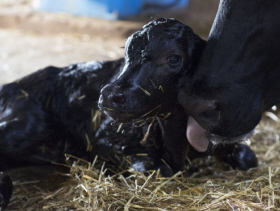



Management Tips: Strategies for Reducing Summer Fertility Lag
When summer winds down and temperatures begin to cool, dairy producers can forget about the lag in fertility as a result of heat stress, writes Todd Bilby, Ph.D., Merck Animal Health. In the two months following the end of summer (varies according to region), fertility still has not reached levels during the cooler months of the year. Plus, milk production usually bounces back to normal levels much sooner than fertility, so milk production may send the false signal that the cows are no longer under heat stress.
In the two months following the end of summer (varies according to region), fertility still has not reached levels during the cooler months of the year. Plus, milk production usually bounces back to normal levels much sooner than fertility, so milk production may send the false signal that the cows are no longer under heat stress.
Heat stress is a growing management challenge for a few reasons. First, with the continued increase in milk production per cow, sensitivity to heat stress also increases. Secondly, higher milk production associated with an increase in dry matter intake enhances metabolic heat production, which aggravates thermoregulatory competence of lactating dairy cattle. Since cows are bred for increased milk production, genetic improvement of dairy cattle escalates the challenges of heat stress at the expense of reproduction.
Research shows that milk production declines during summer months, and fertility declines even more. Depending on the severity of heat stress and amount of cow cooling techniques, it’s common for milk production to drop 10 to 30 percent and fertility to drop 30 to 70 percent. So as cows continue to produce more milk, fertility will be a year-round challenge and even more so during the heat stress season.
Embryo survival also is a factor of heat stress. Prior to ovulation, eggs (still in the growing follicle) obtained from dairy cows during the summer heat stress period have a reduced ability to become fertilized and make a viable embryo. New growing embryos (2 to 3 days of life) also are more susceptible to heat stress than other stages of life.
For dairy producers who have bulls for natural breeding, dairy bull fertility is negatively impacted by heat stress, including decreased sperm concentration, lower sperm motility and increased percentage of abnormal sperm. After a period of heat stress, semen quality does not return to normal for approximately two months because of the length of the spermatic cycle – extending the effects of heat stress on reproduction. The use of frozen-thawed conventional semen and AI bypasses the effects of heat stress on male fertility. So if you use natural breeding after a certain number of AI breedings, you may want to consider extending your AI breedings to avoid the deleterious effects during – and two months following – heat stress.
With the extreme reduction in fertility and the effects on the early growing embryo, producers should continue to focus on keeping cows cool until the temperature humidity index (THI) is under the recommended limit of 68. This will help fertility rebound sooner, increase the embryo survival rate and improve the reproductive performance of your herd.
Consider these heat stress management tips to minimize the effects of heat stress during and two months after summer.
- Provide proper cooling. Shades, soakers and fans should be located in places that are extremely hot and where cows spend most of their time. The holding pen tends to be very hot. Consider the close-up, fresh and dry cow areas as well.
- Cool longer. Use cooling systems until the THI has dropped below 68. Don’t turn them off too early or stop maintenance too soon because fall is approaching.
- Remember the bulls. If using natural breeding after a certain number of AI breedings, consider extending AI breedings through the summer and two months after heat stress.
- Provide adequate water. Water consumption increases 1.2 to 2 times during heat stress conditions. Since milk is 90 percent water, how much cows drink is vital to milk production and maintained thermo homeostasis.
- Work when it’s coolest. Vet checks, pen moves and lock-up should be completed early in the morning when cows and temperatures are the coolest. A cow’s body temperature is warmest between 6 p.m. and midnight, so reducing activity during this time is best.
- Utilize a robust timed AI program. A timed AI protocol can help improve fertility during summer months. Research has shown that a TAI protocol increased pregnancy from 16.5 percent in the control group to 27 percent in the TAI protocol, while decreasing days open, interval from calving to first breeding and services per conception.
- Assess heat stress on your dairy. There are tools and simple strategies to evaluate if your cows are heat stressed. Use new apps, temperature devices, measure respiration rates, evaluate lying times, etc., to evaluate the severity and location of heat stress.
Managing heat stress at the end of summer is similar to taking a seven-day antibiotic pack when you’re sick. You may start feeling better after day four or five, but it’s important to take the medication for all seven days to be completely cured. In much the same way, cows will be more comfortable at 40 to 50 degrees, 20 to 30 degrees cooler than our comfort zone. So when you’re feeling comfortable, it’s not a sign that your cows are comfortable too. Keep your heat stress management strategies in place until fall temperatures reach at least 68 to 70 THI to avoid the summer fertility lag.
Todd Bilby, Ph.D., is a dairy technical services manager for Merck Animal Health in Ft. Worth, Texas, and specializes in dairy reproduction, cow comfort and transition cow management.



